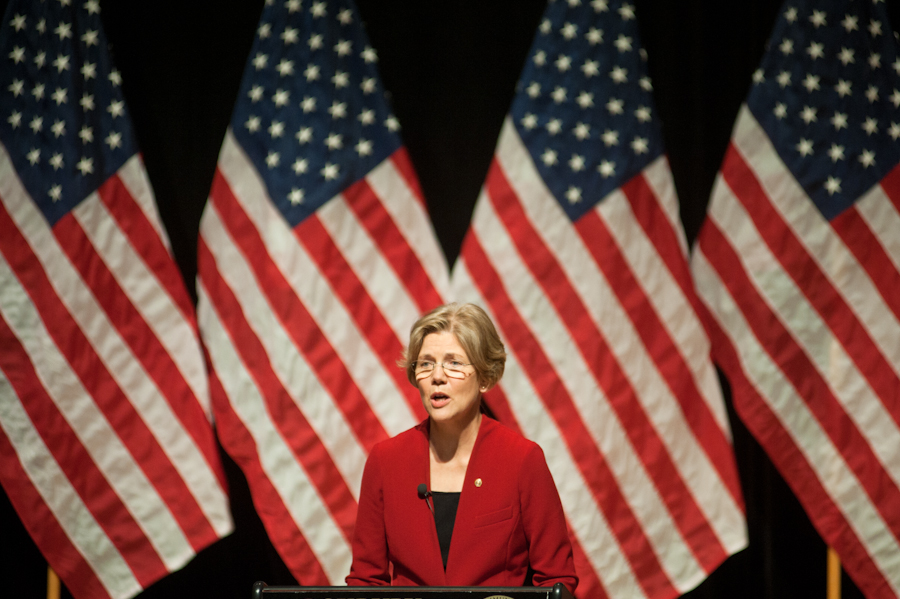Five times in the history of the United States, the results of the Electoral College and popular vote have differed. In 2000, George W. Bush defeated Al Gore with 543,895 fewer votes. That election thrust the Electoral College into the national spotlight and spurred debate over reform. In 2016, Donald Trump defeated Hillary Clinton despite receiving nearly three million fewer popular votes, meaning that two of the last three Republican presidents have lost the popular vote. After 2016, the debate over the Electoral College became increasingly partisan.
Why Is It a Problem?
The Electoral College preserves a level of federalism that protects the interests of smaller states from majority rule, as the electoral votes of smaller states overrepresent their populations. In 2016, Wyoming cast 255,849 popular votes and California cast 14,181,595. Wyoming has three electoral votes and California has fifty-five votes, meaning Wyoming cast one electoral vote for every 85,283 voters while California cast one electoral vote for every 257,847 voters. In other words, a voter in Wyoming is over three times more influential than a voter in California. It’s worth noting that this statistic considers actual votes cast in 2016, rather than all registered voters. Many voters in large states such as California are dissuaded from voting, as the Electoral College dilutes their votes.
Similarly, the most commonly used winner-take-all mechanism does not accurately reflect national will. By giving all of a state’s electoral votes to the candidate who received the most votes in that state, it fails to account for diversity or close results. In 2016, Trump won Wisconsin and Clinton won Minnesota. However, in Wisconsin, Trump won by only one percent of the vote, and in Minnesota, Clinton only won by 1.5 percent. Neither state was close to a landslide, yet each winner took all of the delegates.
Additionally, a winner-take-all system deters third-party candidates. Under the Electoral College, a candidate could win 25 percent of the national popular vote, yet gain no electoral votes. Although the Electoral College is not the only institution promoting the duopoly, its design still creates a wasted vote sentiment by forcing voters to choose between two candidates.
How to Fix It
In 2012, 69 percent of Democrats and 54 percent of Republicans supported abolishing the Electoral College; in 2018, 75 percent of Democrats but only 32 percent of Republicans did. This split reflects not only the benefit that the Electoral College has given to Republicans, but also the country’s larger partisan divide. Therefore, any proposed changes must be mindful of this cleavage. Reform must be incremental in order to have bipartisan support.
According to Article II of the Constitution, each state appoints electors “in such Manner as the legislature thereof may direct.” While states are required to have as many electors as they have representatives and senators, they are free to decide how their electors vote. Such changes to state law are made either by the legislature or ballot initiatives. However, one state’s reform will not fix the country’s problem; any potential reform must have widespread, multi-state appeal.
One proposed reform is the Whole Number Proportional (WNP) System, where the Electoral College is reformed through state laws. Under this system, a state’s Electoral College votes are divided proportionally among candidates based on the state popular vote, preserving the electors’ current role. As with any system preserving the Electoral College structure, the result may differ from the popular vote. However, by dividing the electoral votes, this proportional system eliminates the winner-takes-all issue and lowers the odds of the national popular vote winner losing the Electoral College.
This solution has bipartisan appeal. For Democrats, WNP is an incremental step in the right direction. For Republicans, WNP preserves the benefit to smaller states and alters the status quo less than other reform proposals.
Furthermore, this proposal modifies, rather than eliminates, the original system. It does not require a constitutional amendment; rather, it can be achieved through state law. In order to achieve bipartisan support, this legislation must be framed in a mutually beneficial matter. For example, it will benefit Republicans in large blue states like California and New York, and it will benefit Democrats in large red states like Texas.
Two states—Maine and Nebraska—already split their electoral votes, reserving two for the winner of the state popular vote and distributing the rest to the winners of each congressional district. Maine adopted this rule prior to the 1972 election, and Nebraska made this change before the 1992 election. Each state has only split their vote once—in 2016 and 2008, respectively.
While this system offers a possible remedy, assigning votes based on congressional districts crosses a dangerous line. Not only does this system hurt voters in gerrymandered districts, but it also encourages further gerrymandering. Furthermore, most gerrymandering falls along racial lines, so distribution based on congressional districts would increase the racial disparities of the Electoral College. While Nebraska and Maine provide a template for eliminating winner-take-all laws, future reforms should not use congressional districts as the method to split the votes.
Why not a National Popular Vote?
In March 2019, a Politico and Morning Consult poll found that 50 percent of voters prefer to elect the president by a national popular vote. This movement has gained traction in recent years, and, since 2006, the District of Columbia, Delaware, Hawaii, Rhode Island, Vermont, Colorado, Connecticut, Maryland, Massachusetts, New Jersey, New Mexico, Oregon, Washington, California, Illinois, and New York have ratified the National Popular Vote Interstate Compact (NPVIC). By ratifying the Compact, these states committed to selecting their presidential electors according to the national, not state, popular vote. The NPVIC would render the Electoral College practically irrelevant by taking effect as soon as the joined states have a cumulative majority of the electoral votes (270).
While these states vary in size, Hillary Clinton won each of them in 2016. This is one of the key struggles with the NPVIC; the states that have already joined are strongly Democratic, and obtaining the necessary electoral votes will require Republican, Republican-leaning, or swing states to join. Furthermore, some constitutional scholars argue that the NPVIC exceeds the states’ constitutionally delegated authority under the Interstate Compact Clause. This plan highlights the importance of constitutional simplicity and bipartisan support for Electoral College reform.
Why WNP?
The Whole Number Proportional plan provides a middle ground between the NPVIC and district-based allocation. By representing the statewide popular vote, rather than districtwide popular votes, it mitigates the effects of gerrymandering and better represents the majority opinion. It avoids the difficulty of a constitutional amendment and has greater bipartisan appeal than the NPVIC.
While Democrats tend to favor Electoral College reform, WNP still raises some concerns. In order to appeal to progressives, this proposal must be framed as an incremental, indisputably legal step toward further reform that increases fairness and representation. Furthermore, Electoral College reform can appeal to those with originalist views. If the Electoral College was designed to prevent tyranny by the majority, then the current state system of winner-takes-all goes against that intuition. This reform is simply an update given the vast increase in population and polarization since the Constitution was drafted.
WNP will increase the influence of voters regardless of where they vote. Removing the winner-take-all effect makes swing states less important. Candidates will campaign in competitive areas rather than competitive states, and campaigns will be more representative of the country. This change will increase the number of campaign events in states like California and Texas and better engage the entire country in presidential campaigns. Furthermore, in focusing less on swing states (which are mostly white) WNP will better engage historically underrepresented groups. Additionally, WNP will better represent minority parties, including third parties, red voters in blue states, and blue voters in red states.
Furthermore, as our country’s politics and demographics shift, either party can face an electoral inversion, as Democrats did in 2000 and 2016. Formerly safe states are becoming less so, and Republicans should be wary of assuming that the system works in their favor. For example, Republicans usually need Texas to win the Electoral College, but it is rapidly becoming competitive for Democrats with popular challengers such as Beto O’Rourke. While past electoral inversions have benefited Republican presidents, shifts in voter ideology and demographics could change this pattern. WNP is not a partisan attempt to regain control of the executive branch; rather, it is a preventative measure to preserve our country’s democratic integrity.
Electoral College reform also has the benefit of not being a large social issue. Unlike marriage equality and reproductive rights, it does not relate to people’s moral or religious beliefs. Many political issues are so closely tied to people’s ethics and principles that there is often little room for compromise. By avoiding strong moral frames, especially with an incremental step, advocates can hope to achieve bipartisan success.
Looking to the Future
The success of WNP heavily relies on future political developments. For example, the 2020 census will bring about redistricting that could affect gerrymandering and the makeup of state legislatures for the next decade. Swing states like Wisconsin, Michigan, and Pennsylvania, where Electoral College reform could be most effective, use census data for redistricting.
Additionally, the 2020 election will heavily influence Electoral College reform and the success of this plan. During their presidential campaigns, most Democratic candidates—including Bernie Sanders, Elizabeth Warren, Pete Buttigieg, and Amy Klobuchar—supported reforming or eliminating it. A Democratic win in 2020 would bring Electoral College reform to the national agenda.
In the age of extremism, WNP provides a stark contrast. It lacks controversy and an ethical background, instead targeting structural change that can appeal to both sides. This combination sets WNP above other proposals for Electoral College reform and apart from most other issues. Its relative simplicity is strategic, not ignorant. Moderate proposals like WNP can be the steps toward progressive goals.
American government is supposed to be for the people, not the states. The Whole Number Proportional System will move toward essential Electoral College reform in a manner that will incrementally garner broad public support.



